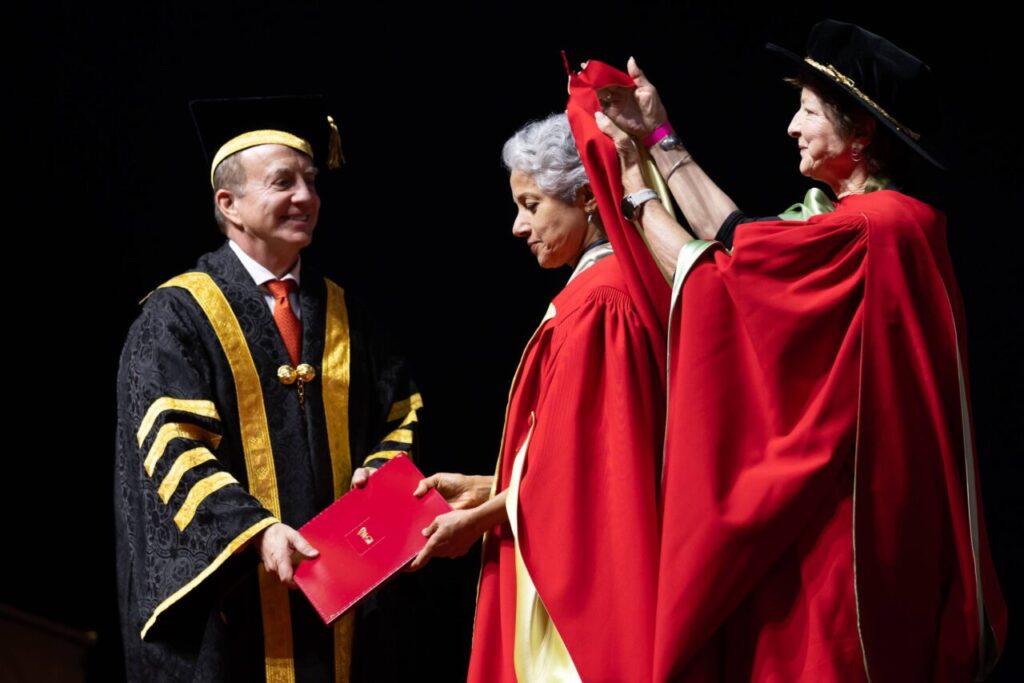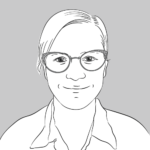
Soumya Swaminathan, MD, was conferred a Doctor of Science, honoris causa, at the Health Sciences “A” ceremony on May 28, 2024, during which she also delivered the Convocation Address to medical and dentistry graduates. A pediatrician and infectious disease researcher – with a particular interest in tuberculosis and HIV – as well as a global and public health activist, Dr. Swaminathan served as the World Health Organization (WHO)’s inaugural Chief Scientist during the COVID-19 pandemic. In her more recent roles, she continues to battle misinformation and the health impacts of climate change. Dr. Swaminathan spoke to Health e-News about the hard lessons learned from the pandemic and offered some words of wisdom to the clinician-scientists of tomorrow.
What does receiving this honorary doctorate from McGill University mean to you?
I was delighted, honoured and humbled. The list of the 10 awardees for this year are all very, very accomplished and impressive people in their own right. It was a double delight for me because my father, Prof. M. S. Swaminathan, who was a very well-known agricultural scientist, also received an honorary doctorate from McGill University many years ago. It’s really nice to have two people from the same family be honoured like that.
You were the WHO’s first Chief Scientist, a role you held during the tumultuous COVID-19 pandemic period. Do you think the world is better prepared to deal with such crises in the future? Looking back, what were your biggest lessons from the pandemic?
The world in many ways is better prepared, but not enough. We lost lives unnecessarily because people did not have access to simple things like PPE or oxygen – and later, of course, to vaccines and drugs. Despite that, countries still don’t seem able to agree. It’s become a rich versus poor country divide, which is very sad and not a good sign for how the world might face the next pandemic.
My first and biggest lesson was that science and technology today can find solutions for a lot of the problems that we face because we have advanced so much. We have so many new tools. If the world comes together and wants to tackle a problem, it can be done, as scientists did during the pandemic. This is why we were able to so quickly advance our understanding of the virus and the disease, and also develop drugs, diagnostics and vaccines.
The second lesson was that countries that had invested in public health, and particularly in primary healthcare and community health workers, actually did much better, even though they may not have had the most advanced hospitals. That’s because, in a pandemic, you need large scale behaviour changes and you need trust. You can’t build trust during a crisis. Countries where trust was low between people and governments did much worse in terms of having more infections and deaths.
The third lesson for me was the rise of misinformation and disinformation. This was a huge surprise. Maybe it should not have been, but I had not expected it. And so, one not only had to do the science and communicate the science, but constantly fight misinformation as well. And also, there were personal attacks which go with the social media presence. And being a woman, there was a lot of misogyny that manifested itself. It was a painful lesson.
The fourth lesson was the fact that the inequities were so glaring and, though I was at the WHO, feeling rather helpless. Because, despite the fact that we had established a framework for how we could distribute and make products in an equitable manner – which countries had actually agreed to – when it came to the crunch, when vaccines actually started getting manufactured, some countries took a disproportionate share because they had the capacity to pay in advance, which poor countries did not. Setting up COVAX [pandemic-era WHO initiative for equitable access to COVID-19 tests, treatments and vaccines] was a beautiful idea and a way to solve this issue of global inequity. But everyone must play ball.

You mentioned that the emergence of misinformation caught you off guard and in your Convocation address you entreated graduates to “Stand up for science and rationality.” Unfortunately, misinformation seems to have worsened. What are your thoughts on how to win the public’s trust in science and evidence-based policies and interventions?
That’s a tough one. One thing I believe we can do is to communicate more. Scientists should communicate with the public in language that is easy to understand and that’s not patronising. And also, not to have a one-way conversation. Often, we just talk to people and tell them, ‘Do this, do that.’ We must listen to people’s questions or their doubts and fears – even if we think they are very silly or unfounded or irrational. nless we take them seriously and address them, people are not going to have faith in us. Scientists are generally not trained as public communicators, so I think the only way is for us to communicate openly and transparently.
Recently, I was asked about this because AstraZeneca withdrew their COVID vaccine. It wasn’t because of the side effects, but a lot of people believe that everything that happens to them now is because of a vaccine. Today you have a heart attack or a stroke and it must be the vaccine that you had three years ago. I always explain to people that having COVID is a much bigger risk factor for all of these, so you should be blaming COVID, not the vaccine. Behavioural science is important because it’s about behavioural change, not just knowledge. At the WHO we set up a group to do “infodemiology” because we said this is an infodemic and to deal with it we need a whole new science.
You recently took on a new role as co-chairperson with former New Zealand PM Helen Clark of Our Common Air to combat air pollution. What are your aims for this role?
I’m quite passionate about air quality as one of the important drivers of health. In many developing countries, including India, we have very poor air quality in most of our cities and that’s really affecting people’s health, whether they realise it or not. So as part of this global commission, we’re trying to bring more attention to the problem, but also get the attention of the multilateral banks to invest more in clean air and to convince governments that it’s a very good investment. We finished the first year as a commission and published the first set of reports, and now we have to think about what the next phase of activity is going to be. It’s a low hanging fruit in a way, and it will have immediate, positive impact on health. There are countries like Canada and others that are experiencing wildfires and air quality issues due to that, but in many of the developing countries, especially the cities, it’s not so much the wildfires but other sources of pollution locally.
From your perspective, how are global south countries like India mitigating the climate crisis and adapting to it?
Most of the climate action and the global focus has been on mitigation, unfortunately, and so adaptation has taken a backseat. In fact, it wasn’t until COP28 that we even had health or agriculture on the agenda. The recognition that health impacts of things like heat can be very severe, especially on women and children, is a bit delayed. My focus now is definitely going to revolve around adaptation to climate change in India’s different agroclimatic zones.
You mentioned earlier you were subjected to misogynistic attacks while you were the WHO’s Chief Scientist. Have you faced other challenges in your career as a woman clinician-scientist and how do you see the role of women leaders in global health in the coming years?
I think it’s still a struggle for women and this is across almost all countries. If you look at global health, only a minority of institutions are headed by women. The same is true in India and there are many reasons for this. But it’s a self-perpetuating bias. One has to take a very purposeful approach in order to change this. Those of us who have made it should be able to help other women because one of the things that really helps when you’re at certain points in your career is having a mentor – somebody who can support you and guide you and encourage you to do more than what you think you can. So very often, as women, we tend to underestimate ourselves.
There are initiatives like WomenLift Health, which I’m associated with, which provides leadership training to mid-career women. We have cohorts running in North America, in East Africa and in India, now expanding to South Asia, which gives women in health them those skills and tools and also creates a network for them so that they get those leadership skills at the stage when they can actually use them. But the change is not coming fast enough. We need it to come faster.
As a clinician-scientist, what do you think our priorities for training the next generation of health professionals should be?
As a clinician-scientist, you have to be connected to the people that you are trying to do research on. Once I was told: “You know, you’re busy researching something that is not actually at the top of our priority list.” That taught me an important lesson. There’s room for all kinds of research, but as a clinical researcher, you want to improve health outcomes and so you need to spend a significant amount of time understanding what the actual issues are, what the barriers are and then developing solutions and strategies to overcome them. The other important thing is to think multidisciplinary. In a team, you can always do much more high-quality work than you can as an individual.

Photos by Owen Egan and Joni Dufour
Related:
Watch Dr. Swaminathan’s Convocation Address
Soumya Swaminathan to be conferred Honorary Doctorate at Health Sciences ceremony

